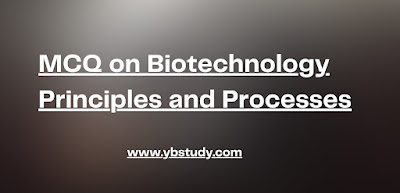MCQ on Biotechnology Principles and Processes for NEET Pdf
Biotechnology Principles and Processes NEET questions with Answers pdf download :
Here we Provide accurate and detailed Answers for all MCQ questions On Biotechnology Principles and Processes. These MCQs are designed by our subject experts to facilitate smooth and easy understanding of any concepts. The NCERT MCQs for Class 12 Biology can be downloaded in the form of a PDF and students can use it as a reference tool to quickly review all the topic wise MCQ given in your Biology textbook Syllabus.
These Class 12 MCQs will help students to build a deeper understanding of each concepts covered in Biology textbook. Practising these MCQ questions will help students to analyze their level of NEET preparation and the Basic knowledge of concepts and clear their doubts quickly.
These MCQ questions may be directly asked in the CBSE board exam or may be in NEET exam also, you may have questions based on similar concepts. So, try to practice these Biotechnology Principles and Processes MCQ with Answers thoroughly to fine-tune your preparations and score good marks in the NEET exam.
MCQ on Biotechnology Principles and Processes :
1. What is the criterion for DNA fragments movement on agarose gel during gel electrophoresis?
(a) The larger the fragment size, the farther it moves
(b) The smaller the fragment size, the farther it moves
(c) Positively charged fragments move to farther end
(d) Negatively charged fragments do not move
Answer: B
2. A gene whose expression helps to identify transformed cell is known as___________
(a) Selectable marker
(b) Vector
(c) Plasmid
(d) Structural gene
Answer: A
3. Which one of the given options correctly identifies its certain component(s)?
(a) Ori – original restriction enzyme
(b) Rop – Reduced osmotic pressure
(c) Hind I, EcoR I – selectable markers
(d) AmpR, tetR – antibiotic resistance genes
Answer: D
4. There is a restriction endonuclease called EcoRI. What does ‘co part in it stand for?
(a) Coelom
(b) Coli
(c) Colon
(d) Coenzyme
Answer: B
5. Given below is a sample of a portion of DNA strand giving the base sequence on the oppositevstrands?
5’____________GAATTC____________3′
5’____________CTTAAG____________3′
What is so special shown in it?
(a) Replication completed
(b) Deletion mutation
(c) Start codon at the 5′ end
(d) Palindromic sequence of base pairs
Answer: D
6. The DNA fragments separated on an agarose gel can be visualised after staining with__________
(a) Bromophenol blue
(b) Acetocarmine
(c) Aniline blue
(d) Ethidium bromide
Answer: D
7. Which of the following restriction enzymes produces blunt ends?
(a) Eco RV
(b) Sal I
(c) Hind III
(d) Xho I
Answer: A
8. A foreign DNA and plasmid cut by the me restriction endonuclease can be joined to forma recombinant plasmid using_____________
(a) Eco RI
(b) Taq polymerase
(c) Ligase
(d) Polymerase II
Answer: C
9. Which of the following is not a feature of the plasmid?
(a) Single stranded
(b) Independent replication
(c) Circular structure
(d) Small, circular double-stranded
Answer: A
10. Commonly used vectors for human genome sequencing are_____________
(a) T-DNA
(b) BAC vectors
(c) T/C cloning vector
(d) Expression vector
Answer: B
11. DNA fragments generated by the restriction endonucleases in a chemical reaction can be separated by_________
(a) Centrifugation
(b) Polymerase Chain Reaction
(c) Electrophoresis
(d) Restriction mapping
Answer: C
12. Biolistics (Gene gun) is suitable for_____________
(a) Disarming pathogen vectors
(b) Iransformation of plant cells
(c) Joining of DNA Vector
(d) DNA Fingerprinting
Answer: B
13. The correct order of steps in Polymerase Chain Reaction (PCR) is____________
(a) Denaturation, Extension, Annealing
(b) Annealing, Extension, Denaturation
(c) Extension, Denaturation, Annealing
(d) Denaturation, Annealing, Extension
Answer: D
14. The process of separation and purification of expressed protein before marketing is called__________
(a) Upstream processing
(b) Downstream processing
(c) Bioprocessing
(d) Postproduction processing
Answer: B
15. Which of the following is not a component of downstream processing?
(a) Separation
(b) Preservation
(c) Purification
(d) Expression
Answer: D
16. A foreign DNA and plasmid cut by the same restriction endonuclease can be joined to form a recombinant plasmid using________________
(a) Eco RI
(b) Polymerase III
(c) Taq polymerase
(d) Ligase
Answer: D
17. Stirred-tank bioreactors have been designed for_________
(a) Purification of product
(b) Addition of preservatives to the product
(c) Availability of oxygen throughout the Process
(d) Ensures aerobic conditions in the culture vessels
Answer: C
18. The Taq polymerase enzyme is obtained from_______
(a) Thiobacillus ferroxidans
(b) Bacillus subtilis
(c) Pseudomonas putida
(d) Thermus aquaticus
Answer: D
19. Which of the following is a restriction endonuclease?
(a) DNase I
(b) Hind II
(c) Protease
(d) RNase
Answer: B
20. The cutting of DNA at specific locations became possible with the discovery of____________
(a) Restriction enzymes
(b) Probes
(c) Selectable markers
(d) Ligases
Answer: A
21. Which one is true statement regarding DNA polymerase used in PCR?
(a) It is used to ligate introduced DNA in recipient
(b) It serves as a selectable marker
(c) It is isolated from a virus
(d) It remains active at high temperature
Answer: D
22. Which one of the following is a case of wrong matching?
(a) Somatic hybridization – Fusion of two diverse cells
(b) Vector DNA – Site for tRNA synthesis
(c) Micro propagation-In vitro production of plants in large numbers
(d) Callus – Unorganized mass of cells
Answer : B
23. Agarose extracted from seaweeds is used in_________
(a) Spectrophotometry
(b) Tissue culture
(c) PCR
(d) Gel electrophoresis
Answer: D
NEET Related Articles :

